Contents
Guide
 EXCITING
EXCITING 
SENSORY BINSFOR CURIOUS KIDS
Easy Creative Play Projects That
Boost Brain Development, Calm Anxiety
and Build Fine Motor Skills
MANDISA WATTS
creator of Happy Toddler Playtime
The author and publisher have provided this e-book to you for your personal use only. You may not make this e-book publicly available in any way.
Copyright infringement is against the law. If you believe the copy of this e-book you are reading infringes on the authors copyright, please notify the publisher at: http://us.macmillanusa.com/piracy.
DEDICATED TO MY THREE AMAZING & CURIOUS KIDS The senses, being explorers of the world, open the way to knowledge. Our apparatus for educating the senses offers the child a key to guide his explorations of the world Dr.
Maria Montessori Picture this: two toddlers around eighteen months old, on their knees, sleeves rolled up past their elbows, heads down, fully engaged in their activity. Their hands are wrist deep in water, swishing around little frozen green peas. One picks up a spoon and starts scooping and pouring the pea and water mixture; the other picks up one of the peas between her fingers and drops it on the mat. They play and explore, listening and chatting this way for about twenty minutes. It may seem as if not much is happening during this short window of play, but for these toddlers, there was a huge amount of learning going on. That is the power of sensory bins and sensory play.
Sensory play allows children to explore their environment using all their senses in a fun and interactive way. But sensory play is also important because it helps build the connections within your childs brain that are necessary for higher learning. It aids with memory formation and development, language development, problem-solving skills, fine motor skills and cognitive development. It can also be a great way to provide relief to an anxious child. Sensory play has the power to open up the world to a child in the most wonderful and unexpected ways. This book will help you create these experiences for your child through sensory bins that are fun and exciting for both of you.
I wrote this book with parents, grandparents, caregivers, teachers or anyone who works with or cares for young children aged eighteen months to three years old in mind. But children ages four through five years old can also enjoy many of these sensory play ideas. So, if you have a toddler as well as a kindergartner at home, you will definitely find ideas here that they will be able to enjoy together, with slight modifications. When deciding which sensory bin to try out, take into consideration a few things:  The age of your child
The age of your child  Your childs interests
Your childs interests  Materials you want to include in the sensory bin
Materials you want to include in the sensory bin  Things you want your child to learn At the top of each sensory bin activity in this book is an age range to let you know which activities are appropriate for which ages. Some sensory bin fillers may pose a choking hazard for young toddlers who still explore their world with their mouth. I always like to remind parents that they know their child best.
Things you want your child to learn At the top of each sensory bin activity in this book is an age range to let you know which activities are appropriate for which ages. Some sensory bin fillers may pose a choking hazard for young toddlers who still explore their world with their mouth. I always like to remind parents that they know their child best.
Youll know exactly what is not safe for them to explore and what is safe. Please use your best judgment when deciding on which sensory bin to create for your little one. The sensory bins in this book are categorized in the following ways:  SMALL WORLD: a real-world scene made for a child to play with
SMALL WORLD: a real-world scene made for a child to play with  SCOOP & POUR: refers to the scooping and pouring actions a child can do with a sensory bin filler
SCOOP & POUR: refers to the scooping and pouring actions a child can do with a sensory bin filler  FINE MOTOR SKILLS: refers to the main skills needed to interact with the sensory bin, such as the movements using the small muscles in the hands and wrists
FINE MOTOR SKILLS: refers to the main skills needed to interact with the sensory bin, such as the movements using the small muscles in the hands and wrists  NATURE: refers to bins that use natural materials like leaves and soils as the main sensory bin filler
NATURE: refers to bins that use natural materials like leaves and soils as the main sensory bin filler  MESSY: refers to sensory bins that tend to create a mess on floors or clothing
MESSY: refers to sensory bins that tend to create a mess on floors or clothing  TASTE-SAFE: safe for young children who still put things into their mouth
TASTE-SAFE: safe for young children who still put things into their mouth  PRETEND PLAY: symbolic play where a child uses their imagination to change objects, actions and ideas to represent other objects, actions and ideas
PRETEND PLAY: symbolic play where a child uses their imagination to change objects, actions and ideas to represent other objects, actions and ideas  SCIENCE: refers to a STEAM (science, technology, engineering, art, math) activity that uses an aspect of science, such as physics or chemistry
SCIENCE: refers to a STEAM (science, technology, engineering, art, math) activity that uses an aspect of science, such as physics or chemistry  ART: refers to a STEAM activity that uses an aspect of art
ART: refers to a STEAM activity that uses an aspect of art  ENGINEERING: refers to a STEAM activity that has an engineering aspect
ENGINEERING: refers to a STEAM activity that has an engineering aspect  LITERACY: refers to a learning activity that focuses on the alphabet
LITERACY: refers to a learning activity that focuses on the alphabet  MATH: refers to a learning activity that focuses on numbers
MATH: refers to a learning activity that focuses on numbers  COLOR: refers to a learning activity that focuses on color Each project has a Setup Time section that is based on the amount of time it will take to create the sensory bin once you have all your materials on hand. If a sensory bin involves taking an additional stepfor instance, if you need to freeze something overnight or create a simple craftI included an estimate of the amount of time for that step. However, this does not include the time it takes to make colored rice, pasta, spaghetti and so on, as the time for these activities will vary depending on the amount you are making. The What to Talk About section provides suggestions on how to further the cognitive and language development aspects of each sensory play activity.
COLOR: refers to a learning activity that focuses on color Each project has a Setup Time section that is based on the amount of time it will take to create the sensory bin once you have all your materials on hand. If a sensory bin involves taking an additional stepfor instance, if you need to freeze something overnight or create a simple craftI included an estimate of the amount of time for that step. However, this does not include the time it takes to make colored rice, pasta, spaghetti and so on, as the time for these activities will vary depending on the amount you are making. The What to Talk About section provides suggestions on how to further the cognitive and language development aspects of each sensory play activity.
When you are using a sensory bin, I encourage you to let your child take the lead. Let them direct the conversation and the play. Remember to never force your child to interact with the sensory bin contents or talk while playing with a sensory bin. If they arent interested in talking, let them play or you can use parallel talk (see ). Children learn and better retain what they learn when play is self directed.

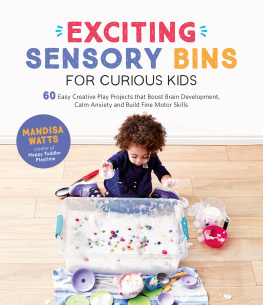



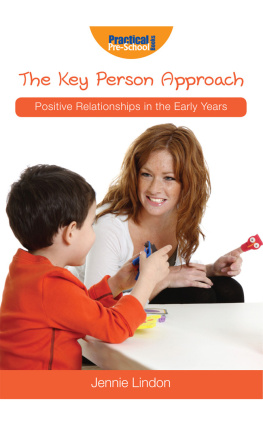
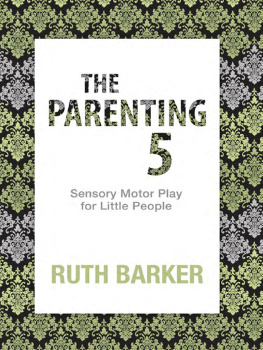
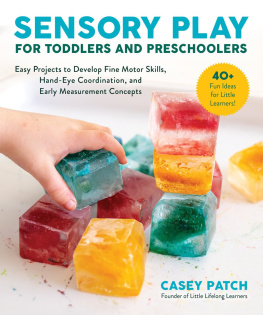
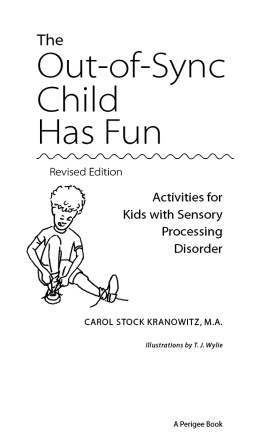


 EXCITING
EXCITING 
 The author and publisher have provided this e-book to you for your personal use only. You may not make this e-book publicly available in any way. Copyright infringement is against the law. If you believe the copy of this e-book you are reading infringes on the authors copyright, please notify the publisher at: http://us.macmillanusa.com/piracy. DEDICATED TO MY THREE AMAZING & CURIOUS KIDS
The author and publisher have provided this e-book to you for your personal use only. You may not make this e-book publicly available in any way. Copyright infringement is against the law. If you believe the copy of this e-book you are reading infringes on the authors copyright, please notify the publisher at: http://us.macmillanusa.com/piracy. DEDICATED TO MY THREE AMAZING & CURIOUS KIDS

 The age of your child
The age of your child